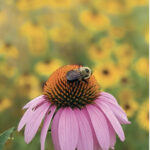 Spring fever is winding down, so now what? It’s time for some tips for the summertime gardener.
Spring fever is winding down, so now what? It’s time for some tips for the summertime gardener.
To water, or not to water? That is the question.
Newly planted trees and shrubs require twice a week watering for a few weeks. A nice soaking once a week into the deep autumn days is usually enough. If we have a long, dry summer, returning to twice-a-week watering may be beneficial. But please remember that over-watering is every bit as bad as under-watering.
Plants respond to water issues the same way—too much or too little will result in wilting. The trickiest part is knowing which plants like wetter soil and which like drier soil. Once you know this, a water meter probe can help gauge soil moisture content for both outdoor and indoor plants.
Also, if your mulch is very deep (over 3 inches is too deep), the water may not even be making it to the root systems. In addition, the mulch “volcanoes” around trunks can cause rot or roots growing up to search, encircling and then strangling the trunk. A mulch ring should look like a low bowl, the mulch only 2-inches deep or less around the trunk of a tree.
Time to Fertilize
Fertilizing your plants can increase vigor and flower power. For annuals and especially hanging baskets, I love Jack’s Blossom Booster. Since annuals only make it one year, fertilizing helps them to be all they can be. For perennials, flowering shrubs and roses, use Espoma’s FlowerTone every six weeks. For evergreen shrubs and trees, HollyTone or PlantTone should be applied. The “Tone” fertilizers are full of slow-releasing, easily applied, granular organic ingredients. Thus, the effect lasts longer—plus soil health is increased. Chemical fertilizers do not help your soil at all and need to be reapplied frequently.
“Dead heading” is not about zombies, but is a term for keeping the faded flowers removed from your plants. While visually tidy, this action also encourages more flowers to grow. Grab a pair of garden scissors and let off some steam.
And how to keep all those weeds away? The number-one way is mulching beds 2 to 3 inches deep (and no volcanoes!). This smothers weed seeds. Hand weeding before seeds are produced is certainly a big plus. Preen is a chemical that can be sprinkled around to suppress seeds that land on top of the mulched beds.
Organically, corn gluten does the same, but needs to be reapplied more frequently. Many people also use the non-selective vegetation killers. Most are chemical concoctions, but some organic choices are emerging. Being non-selective, they will kill anything that is green, not distinguishing between your favorite zinnia and that weed right next to it. If the wind is blowing, the chemical can drift and damage neighboring plants. Wait for a still day and be focused in your action.
Know Thy Enemy
Insect and disease issues can rise up and be simply a nuisance or a full-blown destructive force. Knowing the “enemy” and the name of the plant is imperative to proper treatment. Don’t choose to just “spray something.” Not only is that environmentally irresponsible; most times, it won’t even take care of the issue.
Bring a leaf or the insect to your local experts for proper diagnosis. This saves money and time and gets results. Be aware when using chemicals that advertise their ability to kill lots of different kinds of insects—this also means bees and butterflies! Even hummingbirds sipping nectar can be hurt or killed by the systemic or broad-spectrum chemicals. Beware the chemicals that tout their long-lasting effect. That means they are so heinous that it will be weeks or months until they finally begin to dissipate. Sometimes, the best thing to do when encountering these little spots or holes is…nothing.
Lawn care in the summer couldn’t be easier. Start by raising the mower deck up to 3 inches, and make sure you have a sharp cutting blade. Allowing your grass to grow taller does a few helpful things. Longer grass can photosynthesize (bask in sun for energy) with greater efficiency, making the plant stronger. The resulting height shades the ground, helping to prevent moisture from evaporating as quickly. Longer grass blades equal longer root length, which helps with the drought tolerance of the lawn. And, if all that isn’t enough, leaving your grass a bit longer makes the grass more competitive for holding out against weeds.
Fertilizers should be avoided in July and August, as the lawns don’t need to be forced to grow when we travel through our hot and dry period of the year. Watering early in the morning, deeply fewer times a week, instead of a little every day, is best. The deeper watering will cause the roots to grow deeper. As for weeds, I call ‘em wildflowers… let ‘em be.
Happy Gardening!
Erica Shaffer is a nursery manager with 24 years of experience at Highland Gardens, Camp Hill. She’s also a proud landscape designer, consultant, lecturer, writer, blogger and tree-hugging plant geek. www.highlandgardens.org.





